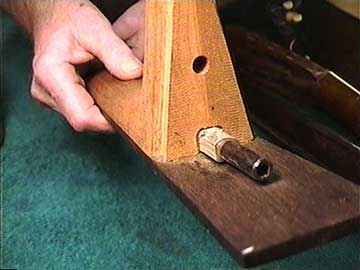FRETS.COM
Illustrated Glossary
Adjustable, usually
Truss Rod
© Frank Ford, 9/27/98 Photos by FF
A truss rod is an adjustable neck reinforcement designed to resist the forward bending
force of the high tension of steel strings. Sometimes a nonadjustable steel reinforcement
is called a truss rod, as the "T-bar" in earlier Martin instruments.
Here's a longitudinal section of a Taylor guitar neck showing its adjustable truss
rod:

You can see the steel rod buried deep in the neck. Above the rod is a maple "filler
strip" which fills the gap between the rod and the fingerboard. Maple or other
hard wood is chosen for filler strips because it resists compression when the rod
is tightened.
Virtually all truss rods work in the same way. When tightened the rod compresses
the back of the neck which is very narrow and soft compared to the front of the neck
(ebony fingerboard.) When the back of the neck compresses, the neck bends backward
in a smooth curve, against the pull of the strings.
A few truss rods are made of other metal elements, which act in the same way,
bending as compression is applied to the surface nearest the back of the neck. Then
when the rod bends, the neck goes with it.
At the peghead end, you can see the adjusting nut set into the pocket which will
have a truss rod cover applied over it:

Near the body, the truss rod is firmly anchored in the heel:

Some truss rods are adjustable inside the body, and have no truss rod cover at the
peghead:

This is a Martin adjustable truss rod, which protrudes inside the guitar body and
is adjustable through the soundhole.
Adjustable truss rods are there only to keep the neck straight. They are not used
for action or intonation adjustments and have absolutely no effect on the neck angle,
so they cannot prevent the need for resetting the necks of older instruments.
Classical guitars do not need truss rods because they have much lower string tension.
Generally, the higher the string tension and the thinner the neck, the more the need
for a truss rod.
More on Truss Rods
Back to Glossary
Back to Index Page



